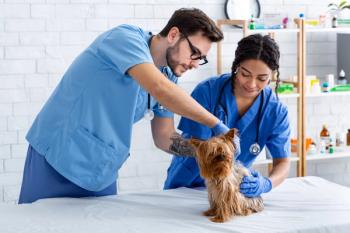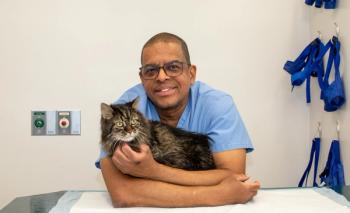
Stabilization of respiratory emergencies (Proceedings)
Animals with acute respiratory distress are often some of the most challenging emergency patients seen by veterinarians.
Animals with acute respiratory distress are often some of the most challenging emergency patients seen by veterinarians. The initial approach to these animals is of utmost importance as it can determine whether these critical patients live or die.
Clinical signs of respiratory distress may be obvious or subtle. Obvious signs of "oxygen hunger" include tachypnea, extended head and neck, abducted elbows, flaring of the nares, cyanosis, open-mouth breathing, anxiety, and inability to rest or lie down. Paradoxical movement of the chest and abdomen also occurs with severe respiratory distress. Signs of respiratory distress are more commonly seen in dogs than cats. Cats often mask the severity of their disease, and commonly the only evidences of respiratory dysfunction are tachypnea and prominent respiratory motions while maintaining a posture of sternal recumbency. Even if these patients appear to be relatively stable, they are often very fragile and have the potential to rapidly decompensate if stressed.
The first step in dealing with a respiratory emergency is to ensure a patent airway. If the airway is not patent, it should be cleared of secretions, foreign body, or other obstruction and immediate intubation performed. The animal should then be ventilated with 100% oxygen at a rate of 20-30 breaths per minute. If an upper airway obstruction prevents tracheal intubation, an emergency tracheostomy should be performed.
Clinicians often have difficulty making the decision to sedate or anesthetize an animal in respiratory distress. If possible, supplemental oxygen should be provided by face mask or "flow by" while assessing the patency of the airway. If there is no improvement and airway examination and intubation are deemed necessary, rapid induction with minimal cardiopulmonary depression can be achieved with Ketamine (5 mg/kg) and Midazolam (0.25 mg/kg) IV or etomadate (0.5 - 2.0 mg/kg IV). Propofol (3-8 mg/kg IV) or thiopental (5-10 mg/kg IV) could also be used but are associated with more severe cardiopulmonary depression in critical patients. Sedation with immediate intubation allows the clinician to take control of the airway and hopefully avoid the prospect of intubating the animal following cardiopulmonary arrest.
There are several methods of supplying oxygen to critical patients, and each has advantages and disadvantages.
"Flow-by" oxygen is convenient, inexpensive, and easily administered to critical patients during the initial examination. Oxygen can also be delivered by face mask, but some animals fight against the mask and become even more stressed. High flow rates of 3-15 L/min are used.
An oxygen cage is useful for cats or dogs in such severe respiratory distress that they may decompensate with even minimal handling. The oxygen cage provides an oxygen rich environment where the patient can "chill out" while the clinician observes the breathing pattern. The disadvantage of oxygen cages is that they are expensive and require large volumes of oxygen to fill the cage. Whenever the cage door is opened, the oxygen level drops substantially, thereby hindering the clinician from making frequent patient evaluations. In addition, animals can easily become overheated in a sealed oxygen cage. Cages that provide temperature and humidity control are safer but are very expensive. If these features are not provided, an oxygen cage should only be used for short term management of dyspneic patients. A bowl of melting ice placed in the cage with the animal may help provide some humidification and temperature control.
Nasal oxygen is an inexpensive and effective alternative to providing oxygen supplementation to animals with respiratory distress. The major advantage is that it allows for continuous delivery of oxygen to the patient while physical examination, radiographs, ultrasound, etc. are performed. This is the preferred method of oxygen support in our hospital for animals that need ongoing support. At flow rates of 50-100 ml/kg (1 liter per 20 lbs), the inspired oxygen concentration is approximately 40%. If the patient remains dyspneic, a second nasal line may increase the inspired oxygen concentration to 60%.
To place a nasal oxygen catheter, several drops of proparicaine or lidocaine are instilled in the nose. A 5-10 F red rubber catheter or feeding tube is lubricated and passed into the ventral meatus to the level of the medial cathus (nasal) or ramus of the mandible (nasopharyngeal). In dogs, passage of the tube is facilitated by pushing the planum nasale dorsally and directing the tube in a ventromedial direction. Suture, staples or super glue can be used to fasten the tube just as it exits the naris and then either over the bridge of the nose or on the lateral aspect of the face. An Elizabethan collar is usually necessary to prevent the patient from dislodging the tube. Contraindications for nasal oxygen are thrombocytopenia, epistaxis, maxillary fractures, disease of the nasal cavities, and severe head trauma in which sneezing could dangerously raise intracranial pressure.
Occasionally, some animals will not tolerate nasal oxygen. Another option is to make an oxygen hood using an Elizabethan collar. The ventral 75% is covered with plastic wrap and the oxygen tubing is placed on the inside of the collar and taped ventrally. It is important to leave an opening at the top to allow for dissipation of heat, carbon dioxide, and condensation. Animals that are obtunded can have a clear plastic bag placed over their head with oxygen provided to make a temporary oxygen tent.
Once supplemental oxygen has been provided, it is important for the clinician to perform a good physical examination and observe the breathing pattern. Classification of the breathing pattern helps direct therapeutic interventions to further stabilize the patient. During initial patient evaluation, an intravenous catheter should be placed and blood drawn for an emergency database (PCV, TS, TUN, glucose and blood smear).
There are five breathing patterns commonly seen in animals that present for respiratory distress.
1) Upper airway obstruction is characterized by inspiratory stridor and noisy breathing. In severe cases, there is paradoxical movement of the abdomen as it is pulled inward during inspiration. The animal may exhibit cyanosis and marked anxiety. Potential causes include foreign body, nasopharyngeal polyp, pharyngeal/laryngeal edema, mass, hemorrhage, laryngeal paralysis, tracheal collapse, or brachycephalic airway syndrome. The clinician should be prepared to sedate and intubate the patient if necessary or perform an emergency tracheostomy if intubation is impossible. Anxiety is often relieved by giving a low dose of acepromazine (30-50 ug/kg IV or IM) or butorphanol (0.2 mg/kg IV) and midazolam (0.25 mg/kg IV). Intravenous fluids and cooling with a fan may be required if the body temperature is increased.
2) Pleural space disease is characterized by rapid, shallow respirations and muffled heart sounds. In severe cases, paradoxical abdominal movement is seen. Causes include pneumothorax, hemothorax, diaphragmatic hernia, chylothorax, pyothorax, right-sided heart failure in dogs, cardiomyopathy in cats, mediastinal lymphoma, and pleuritis. Emergency thoracocentesis should be performed to stabilize the patient before further procedures such as radiographs are undertaken. If fluid is retrieved, microscopic examination of cytology may provide the diagnosis. If air is retrieved, the amount should be recorded, and thoracocentesis should be repeated if needed in 20-30 minutes. Repeated drainage of large amounts of air is associated with tension pneumothorax. This is a life threatening condition in which positive pressure builds up in the thoracic cavity impairing venous return to the heart and precluding adequate lung expansion. Inability to effectively evacuate the pleural space of air or fluid may require placement of a thoracic drain and possibly continuous suction (Pleur-evac, Deknatel, Inc., Falls River, MA).
3) Small airway disease is characterized by prolonged expiration with an expiratory push. Inflammation, smooth muscle hypertrophy, mucus accumulation, and bronchoconstriction of the small airways result in air trapping and difficult expiration. Causes include chronic obstructive pulmonary disease, chronic bronchitis, and feline asthma. The emergency treatment of feline asthma involves corticosteroids (0.2 mg/kg dexamethasone IV or 2-4 mg/kg prednisolone sodium succinate IV) and bronchodilators (terbutalane 0.01 mg/kg IM or SQ or albuterol syrup 0.05 mg/kg PO). Alternatively an inhaler could be used, administering 2 puffs into a pediatric spacer (Opti Chamber, Respironics) and allowing the patient to take 10-12 breaths. Options for inhalation therapy include Flovent (Fluticasone), terbutalane, albuterol, and cromolyn. Cats with feline asthma will show marked improvement within 30-60 minutes after receiving appropriate therapy.
4) Parenchymal disease is characterized by labored inspiration and expiration. Auscultation reveals harsh lung sounds, crackles, and wheezes. Causes include pneumonia, pulmonary neoplasia, infiltrative disease, pulmonary contusions, and cardiogenic and non-cardiogenic pulmonary edema. Dogs with congestive heart failure usually have a heart murmur and tachycardia. Cats with heart failure often have a mild heart murmur, a gallop rhythm or other abnormal rhythm disturbance. If the clinician strongly suspects congestive heart failure as the underlying cause of respiratory distress, intravenous furosemide should be given (2 mg/kg IV q 12 h for cats and repeated up to 4-5 times prn for dogs with severe disease). In addition, 2% nitroglycerine paste (¼ - ½ ") can be applied to a clipped area to provide venodilation and reduce preload in dogs and cats. Severely affected dogs may benefit from a constant rate infusion of nitroprusside. We start at a dose of 1 ug/kg/min and increase it every 15 minutes until improvement in depth and rate of respirations is seen. The effective dose for most dogs is between 5-10 ug/kg/min. Blood pressure must be monitored when this drug is used as it is a very potent vasudilator.
5) Tachypnea may not be a result of primary lung disease. If the lungs sound clear, other causes of tachypnea that must be ruled out include anemia, shock, pain, excitement, anxiety, fever, and metabolic acidosis. Bloodwork and radiographs combined with management of pain and shock should help determine the underlying cause of tachypnea.
Monitoring of the respiratory system involves serial recording of respiratory rate and effort and auscultation findings. Pulse oximetry can be used as a screen for severe hypoxemia. Ideally, readings should be above 94%. Readings lower than this indicate that hemoglobin is not fully saturated and are associated with arterial pO2 concentrations less than 60 mmHg. Low pulse oximetry readings should be confirmed with an arterial blood gas if possible. Inaccurate pulse oximetry readings can be associated with hypotension, motion, shivering, hypothermia, bright ambient light, and pigmented skin. Normal paO2 on room air is 85-100 mmHg. A rule of thumb is that the paO2 should be approximately 5 times the fractional inspired oxygen concentration (FiO2). On room air, it should be 100^, on nasal oxygen it should be 200; on 100% oxygen it should be 500. The paO2 /FiO2 ratio in patients with ARDS is 300 and patients with acute lung injury (ALI) is 200. These conditions have a guarded to poor prognosis.
Another way to assess pulmonary function is through calculation of the A-a gradient. Significant intrapulmonary shunting can be estimated by the following formula: A- a gradient = (150-PaCO2/0.8) - PaO2 when the sample is taken on room air at sea level. In normal animals, the A-a gradient is usually less than 15. Improvement in the A-a gradient can be a good prognostic sign.
Arterial blood gas measurements can also be used to determine whether an animal is able to effectively ventilate. The paO2 should be maintained above 60 mmHg to provide complete hemoglobin saturation and adequate oxygen delivery to tissues. Normal paCO2 ranges from 35-45 mmHg. Arterial carbon dioxide levels above 60 mmHg are associated with impaired ability to effectively ventilate and indicate that the animal may require mechanical ventilation for effective management of the underlying condition resulting in respiratory distress.
Newsletter
From exam room tips to practice management insights, get trusted veterinary news delivered straight to your inbox—subscribe to dvm360.






